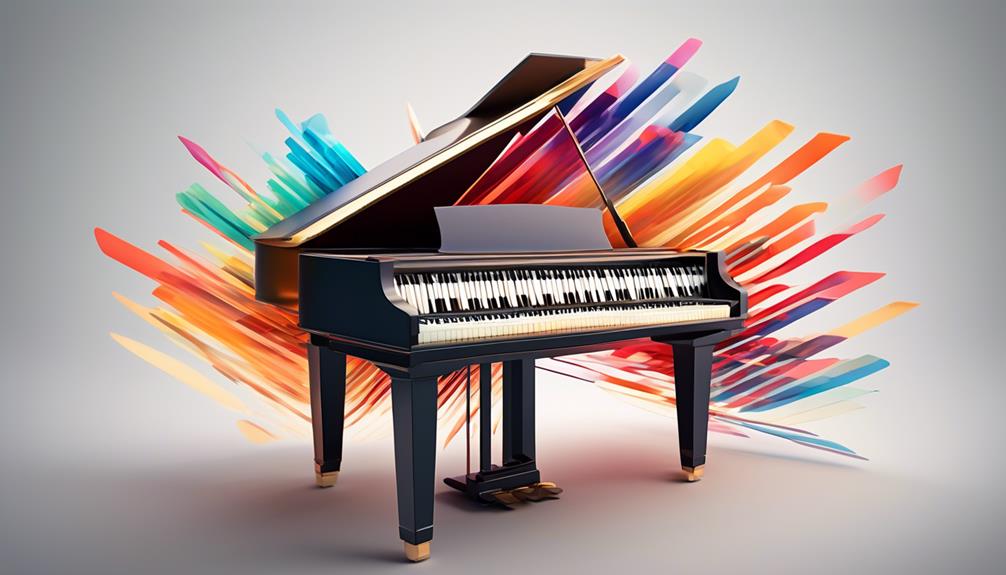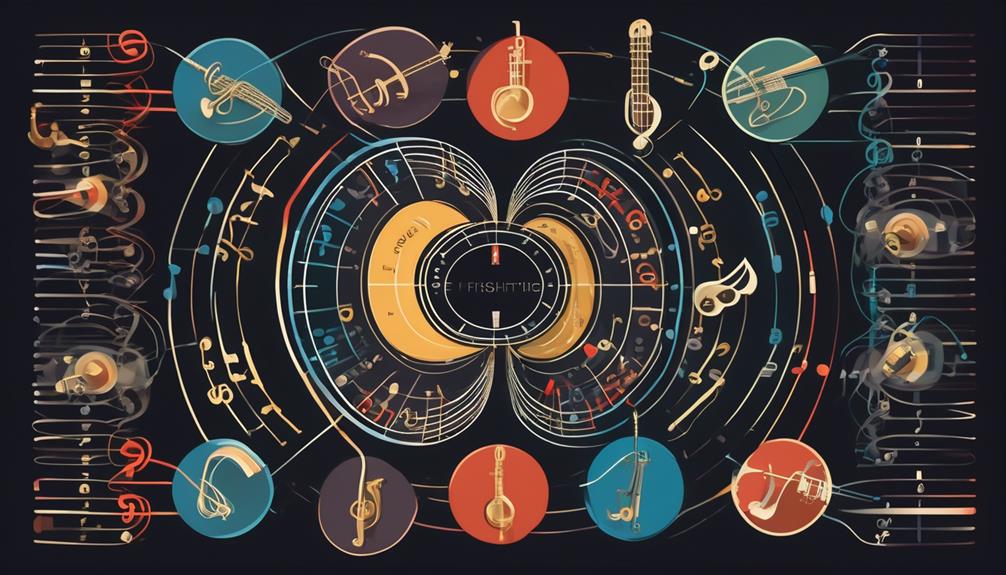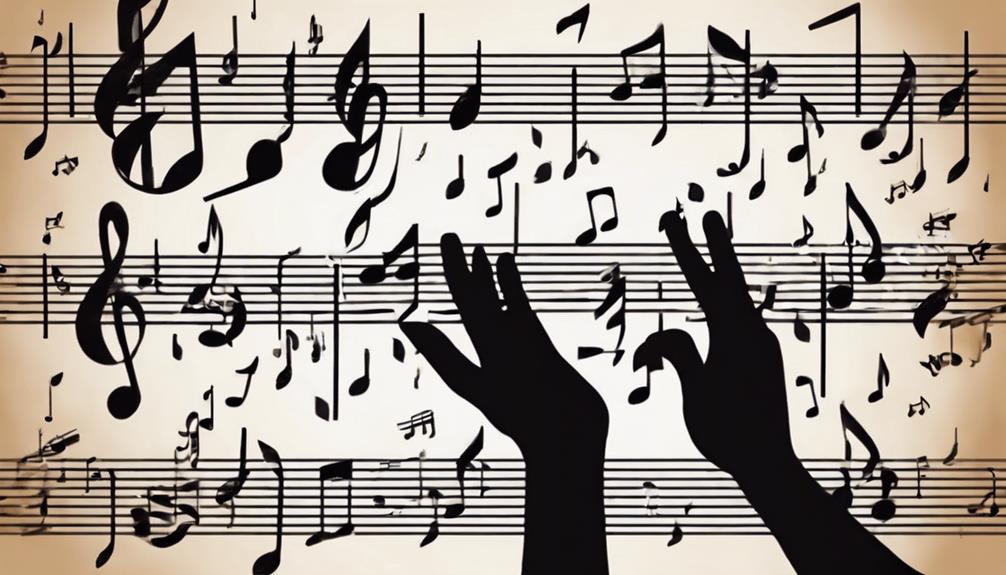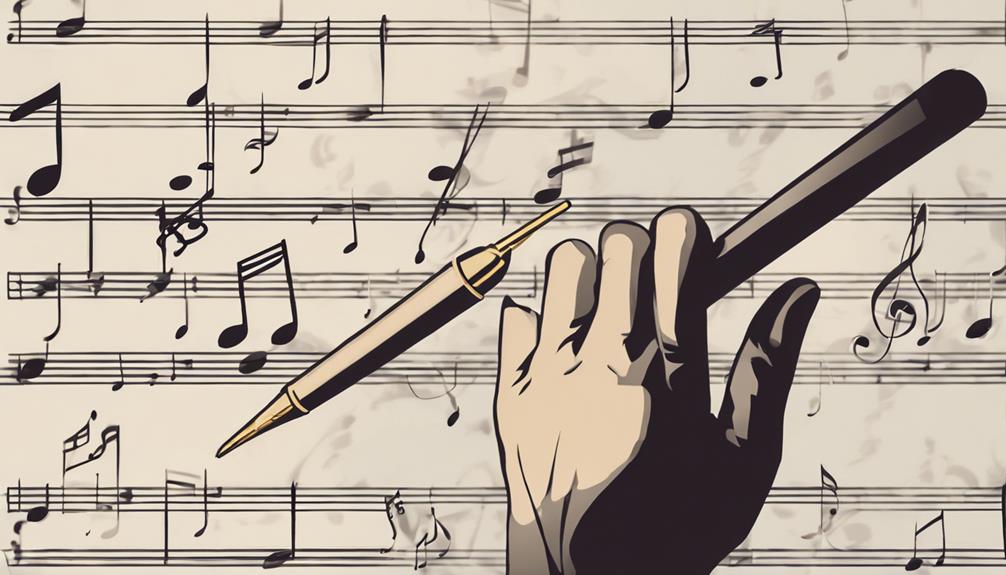No products in the cart.
As a sound designer, grasping music theory is like assembling a complex puzzle; each piece is crucial to the overall picture and your understanding of how they fit together can make or break your project.
You’re not expected to become Mozart overnight, but a solid foundation in these seven key music theory basics will enable you to communicate more effectively with composers and producers, and to design sounds that complement the narrative texture of any scene.
Whether it’s knowing when to challenge conventional tonality or to adhere to it, these principles are your tools.
Let’s explore how a nuanced appreciation of pitch, rhythm, and harmony can elevate your soundscapes from mere noise to compelling auditory experiences.
Stick with me as we uncover how these concepts are not just academic exercises, but practical tools that can vastly enhance your creative arsenal.
Key Takeaways
- Pitch perception impacts emotional response in music, with lower pitches evoking foreboding or solemnity and higher pitches creating lightness or anxiety.
- Scales, modes, and tonality play a crucial role in painting the mood of soundscapes, with modes like Dorian and Lydian evoking specific atmospheres.
- Chord structure, including triads, creates harmonic content and fluid transitions, with chord progressions and voice leading guiding the flow of the music.
- Rhythm and meter provide the pulse and organization of music, with tempo dictating the speed of beats and syncopation and polyrhythms adding texture.
Understanding Pitch and Notes
To effectively manipulate sound in design, it’s critical to grasp how pitch and note choices impact the auditory experience. Pitch perception plays a pivotal role in eliciting emotional response, as the frequency of a sound can convey tension, tranquility, or excitement. Lower pitches often evoke a sense of foreboding or solemnity, while higher pitches can create an atmosphere of lightness or anxiety. Notes, named A through G, with accidentals to modify them, serve as the building blocks for melodies and harmonies that resonate with the listener.
The role of microtonality in experimental music composition can’t be understated. Unlike traditional Western music that typically uses 12 equal intervals within an octave, microtonal music explores the nuances between these intervals. This pushes the boundaries of conventional harmony and enables sound designers to craft unique auditory textures. By experimenting with intervals smaller than a semitone, you can generate fresh emotional landscapes that challenge and expand a listener’s perception.
Understanding intervals, the distance between two pitches, is fundamental for creating specific sounds and characteristics within your compositions. Octaves, where one pitch is double or half the frequency of another, are essential for structuring your sonic palette. Mastering these concepts is indispensable for innovative sound design.
Exploring Scales and Modes
Diving into scales and modes equips you with an array of musical colors to paint the mood and atmosphere of your soundscapes. As a sound designer, understanding these musical structures is crucial to creating melodies and harmonies that resonate with your project’s emotional context. Modes like Dorian, Phrygian, and Lydian, each with their distinct tonalities, serve as invaluable tools for evoking specific atmospheres. They can subtly steer the feelings of an audience in ways that simple major or minor scales cannot.
When you’re using scales and modes in ambient soundscapes, you’re not just filling space; you’re meticulously crafting a sonic environment that can transport listeners to another realm. The careful selection of a mode can conjure a sense of mystery, tension, or even wonder, aligning perfectly with the visual narrative you aim to enhance.
Exploring exotic scales provides unique sound design elements that can set your work apart. These scales often contain intervals and sequences that aren’t commonly found in Western music, offering fresh auditory experiences. By incorporating them into your compositions, you add depth and complexity that captivate your audience, pushing the boundaries of conventional sound design.
Building Chords and Triads

As you build chords, you’ll start with the basics of chord structure, understanding how the simultaneous combination of notes creates the foundation for harmonic content.
You’ll explore triad types, recognizing the differences between major, minor, diminished, and augmented forms, and their roles in composition.
Grasping chord progressions and voice leading principles is key to developing fluid transitions and compelling sonic narratives in your sound designs.
Chord Structure Fundamentals
Understanding the basic structure of chords and triads is crucial for sound designers looking to craft harmonically rich and emotionally resonant sounds. Chords are synthesized by stacking multiple notes, typically derived from a key’s scale.
A major chord, known for its bright and happy aura, combines the root note with a major third and a perfect fifth. Conversely, minor chords, with their melancholic timbre, are formed using a root note, a minor third, and a perfect fifth.
Triads, the most fundamental chord type, consist of these three critical notes: root, third, and fifth. Delving into chord inversions and voicings can drastically alter a chord’s character, providing innovative textures to your sonic palette.
Mastery of these elements is indispensable for devising compelling harmonic progressions in your sound design.
Triad Types Explained
Building on the chord structure fundamentals, let’s examine the specific types of triads, as each one forms the backbone of the chords you’ll use to create nuanced soundscapes. As a sound designer, it’s crucial to grasp triad variations to effectively manipulate the emotional impact of triads in your compositions.
| Triad Type | Emotional Impact |
|---|---|
| Major | Bright, Happy |
| Minor | Melancholic, Somber |
| Diminished | Tense, Dissonant |
| Augmented | Intense, Bright |
Understanding these building blocks enables you to innovate within your sound designs, tailoring emotional resonance with precision. Each triad type serves as a tool for sonic storytelling, allowing you to craft moods that can shift from joyous to eerie with just a few interval adjustments.
Progressions and Voice Leading
Delving into progressions and voice leading, you’ll discover their pivotal role in constructing coherent and emotive chord sequences within your sound designs. By analyzing chord progressions, you can craft a narrative that guides listeners through your sonic landscape, while creating smooth transitions ensures that your chord structures flow seamlessly.
Consider these elements:
- Harmonic Movement: Provides direction and momentum.
- Connection: Ensures notes lead naturally from one chord to another.
- Emotion: Achieved through the careful selection of chordal relationships.
- Cohesion: Maintains a sense of unity throughout your piece.
- Expression: Voice leading nuances can greatly enhance the emotional impact.
Understanding these technical aspects equips you to innovate and create rich, expressive sound designs that resonate with your audience.
Rhythmic Fundamentals


To effectively design soundscapes that resonate with listeners, it’s essential to grasp the rhythmic fundamentals that form the backbone of musical structure, including beats, tempo, measures, and meter. You’ll need to master syncopation techniques and understand the intricacies of polyrhythms and cross rhythms to add texture and depth to your compositions.
Beats are the steady pulse you feel in a piece, a constant tick that gives music its temporal skeleton. Tempo, measured in bpm, dictates the speed at which these beats occur. By manipulating tempo in digital audio workstations like Pro Tools, you can dramatically alter the energy and mood of your sound designs.
Measures organize these beats into groups, typically separated by bar lines, and are essential for synchronization, particularly when working with other musicians or aligning sound to picture. Meter, indicated by time signatures, outlines the beat pattern within each measure. This framework is pivotal in creating rhythmic complexity and propelling your sound narratives forward.
Here’s a table to clarify these concepts:
| Element | Function | Significance |
|---|---|---|
| Beats | Provide a steady pulse | Forms the temporal foundation |
| Tempo | Sets the speed of music | Influences energy and mood |
| Meter | Dictates rhythmic pattern | Shapes the overall feel |
Understanding these elements allows you to craft compelling rhythmic structures that captivate and move your audience.
Time Signatures and Meter
Having mastered the rhythmic fundamentals, you’ll now find that time signatures and meter further refine your understanding of musical structure, allowing for nuanced sound designs that follow a coherent rhythmic framework. Time signatures serve as a foundational element in your quest for innovative soundscapes, dictating the rhythmic pulse and driving the tempo of your creations.
- Embrace Complexity: Dive into the world of syncopation and polyrhythm to craft intricate sonic textures.
- Innovate with Intent: Utilize uncommon time signatures to break free from conventional rhythmic patterns.
- Manipulate Mood: Leverage the importance of tempo and tempo changes to shape the emotional arc of your audio narratives.
- Engineer Ebb and Flow: Experiment with meter to build tension and release within your compositions.
- Craft Cohesion: Establish a consistent rhythmic identity that glues disparate sound elements together.
When designing sound, it’s crucial to consider how these elements interact. Syncopation can inject energy and surprise, while polyrhythms introduce a complex, layered feel to your work. Equally, the importance of tempo and tempo changes can’t be overstated; they’re powerful tools for manipulating listeners’ responses.
Key Signatures and Tonality


As you design soundscapes, it’s crucial to grasp key signatures, which map out the prevalent sharps and flats, shaping the harmonic framework of your audio pieces.
They’re not just symbols on a staff; they influence the tonality, guiding the mood and emotional direction of your work.
A solid understanding of key signatures will streamline your approach to pitch correction and EQ settings, ensuring your compositions resonate with the intended atmosphere.
Understanding Key Signatures
When you’re diving into the realm of sound design, grasping the concept of key signatures is essential, as they form the backbone of a composition’s tonality and influence its emotional impact. Key signatures define the scale that your piece will follow, and it’s vital for analyzing chord progressions and identifying key changes efficiently.
Key signatures determine the sharps and flats throughout your composition. They streamline the process of pitch correction and EQ adjustments.
Understanding key signatures enables precise chord construction and progression. Recognizing key changes is crucial for maintaining musical cohesion.
Key signatures are foundational in evoking specific emotions through music.
As a sound designer, your innovative edge comes from exploiting these elements to create a soundscape that resonates with your audience both technically and emotionally.
Exploring Musical Tonality
Key signatures not only map out the essential pitches in your composition but also shape its tonality, affecting the emotional ambiance of your sound design. As you delve into tonal color exploration, you’ll discover that key signatures are crucial for tasks like pitch correction and EQ adjustments. They help you create harmonious arrangements that resonate with your intended audience.
Understanding the key signature provided by the songwriter empowers you to enhance the musicality of the composition. By using tools such as the Chords Ruler in Pro Tools, you can perform melodic contour analysis and adjust chords to perfect the progression, enriching the sonic narrative.
Here’s a quick guide to understanding key signatures:
| Key Signature | Emotional Ambiance |
|---|---|
| C Major | Bright, Happy |
| A Minor | Mysterious, Sad |
| G Major | Warm, Euphoric |
| E Minor | Melancholic, Soothing |
| D Major | Lively, Triumphant |
Harmonic Progressions
To effectively craft compelling soundscapes in sound design, it’s essential to grasp how harmonic progressions shape the emotional and tonal landscape of a piece. Analyzing harmonic progressions in film scores can offer valuable insights into how composers convey narrative tension and character emotions. Similarly, by applying harmonic progressions to create tension in sound design, you can produce a more immersive and emotionally resonant experience for your audience.
Consider these key points:
- Harmonic progressions provide a roadmap for emotional storytelling within a soundscape.
- They’re the building blocks for creating moments of anticipation, resolution, or uncertainty.
- Familiarity with various chord sequences allows for innovative and expressive sound design.
- Skillful manipulation of progressions can subtly guide the listener’s emotional response.
- Knowledge of harmonic theory enables sound designers to construct sonically cohesive environments.
Frequently Asked Questions
What Are the Five Basic Elements of Sound Design?
You’re dealing with sound, dialogue, music, effects, and silence. These elements, mastered through frequency modulation and waveform synthesis, are pivotal for innovative and emotionally resonant sound design in any cutting-edge production.
Do Sound Engineers Need to Know Music Theory?
You don’t strictly need music theory to operate technical equipment or excel in sound mixing, but it’ll sharpen your skills and innovate your approach to engineering sound in complex and harmonious ways.
What Are the Basic Idea and Concepts of Sound Design?
You’ll explore acoustic treatments and digital synthesis, harnessing them to craft unique sounds that tell a story, evoke emotions, and push the boundaries of what’s sonically possible in innovative sound design.
What Is Sound Design Theory?
You’ll explore aural aesthetics and sonic textures in sound design theory, analyzing how sounds shape experiences and emotions in media, pushing the boundaries of technical expertise for innovative storytelling.
Conclusion
You’ve delved into the essentials of music theory, grasping how pitch and notes form the building blocks of sound design. Exploring scales and modes has broadened your palette, while mastering chords and triads has deepened your understanding of harmony.
Rhythmic patterns, meter, and time signatures have equipped you with temporal precision. Key signatures and tonality have fine-tuned your sonic backdrop.
Now, use harmonic progressions creatively to sculpt audio landscapes that resonate with your game’s aesthetic and narrative.




